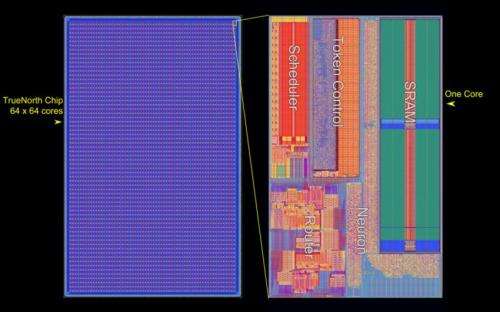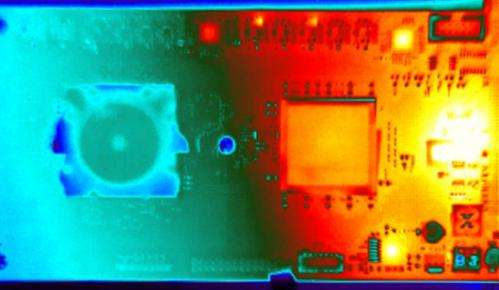TrueNorth: a 'brain-like' chip to turn computing on its head

Computers and brains work in virtually opposite ways. Computers are laboriously programmed for specific tasks. Brains learn from experience and can perform a wide variety of complicated tasks that are currently impossible for a computer.
But in the journal Science today, scientists from IBM and Cornell University published details of a computer chip called TrueNorth that mimics much of what we know about how the brain works – and the possibilities for such technology are mind-boggling.
Normal computers contain a handful of extremely complicated, extremely fast and extremely powerful chips (central processing units or CPUs).
Brains, on the other hand, work with a huge number of much simpler and slower neurons (brain cells). A bee brain contains about a million neurons and a human brain around 86 billion. But it's the way these neurons work together that makes brains so clever.
How does TrueNorth work?
In a brain, each neuron is connected to thousands of others. Neurons send signals to each other using tiny electrical discharges called spikes. When a neuron receives the right number of spikes from other neurons at the right time, those incoming spikes make a pattern (such as dots on a page).
If the pattern matches one that the neuron has learnt through experience (such as a certain pattern of dots that it has seen many times before), it will send out a spike of its own to the thousands of other neurons that it connects to. That spike will add to the patterns being seen by all those other neurons.
TrueNorth works exactly the same way as the brain. Instead of a small number of big CPUs, it has a huge number of small artificial neurons, all connected.

Normal computers can perform precision calculations with blinding speed, but brains can deal with imprecision and vague decisions in a constantly changing world. Exactly how brains do this we don't fully understand, but we hope to learn more by building brain-like computers and studying what they're capable of.
One of the clues seems to be that the patterns a neuron sees don't need to be exact. They can be out of time, or have missing dots, but the neuron will still respond. This helps give the brain the ability to deal with the vagueness and unpredictability of the real world.
What can TrueNorth do?
The short answer is: plenty. Normal computers are dumb. Sure, there have been many attempts to make them appear smarter than they are, such as Apple's personal assistant Siri (and does anyone remember the paperclip from Microsoft Word?), but even though they are starting to access brain-like technology in the cloud, they are still at the gimmicky stage.
For working on spreadsheets and word processing, for complex engineering calculations, secure financial transactions, fast information retrieval and computer games, normal computers work well.
But all these activities happen mostly inside the computer (or inside a computer network) and are controlled by us through relatively simple interfaces such as keyboards, mice and touchscreens. We use these simple interfaces because they are easy for the computer to understand.
Put a normal computer in the real world – to understand speech in a noisy office, to recognise you in sunglasses or after a radical haircut, to read text and actually understand it well enough to answer questions, to notice what we are doing and offer genuinely helpful advice – and it will fail.
Brain-like computers will be able to do all these things and much, much more.
The future
Once computers can recognise and understand things in the real world, they can get out of the boxes and screens they are currently inside, and start actually doing things for us.
Once a computer knows what a floor is, put it in a small robot and it can vacuum (simple examples of this already exist). Once a computer knows what shelves and cereal boxes are, it can restock the aisles at the supermarket. Other computers can undertake difficult and dangerous construction and industrial jobs and perform hazardous rescues on mountaintops or in burning buildings.
The possibilities are nearly endless. Brain-like computers promise to change the world in ways we can't yet even imagine.
Journal information: Science
Source: The Conversation
This story is published courtesy of The Conversation (under Creative Commons-Attribution/No derivatives).
![]()





















